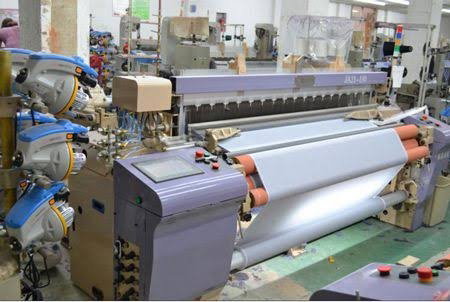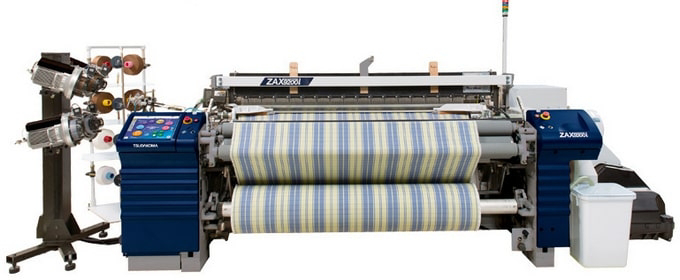Different Parts of Air-jet loom and their function in weft insertion:-
Different Parts of Air-jet loom and their function in weft insertion:-
Air jet filling insertion is the simplest way of inserting the filling yarn which probably explains why air-jet weaving machines are one of most popular machines in the market today.
Image of Different parts of air jet weavning machine and their function ref. by textile learner.
1) Tensioner.
Additive disc type tensioner is used for weft insertion which maintains proper tenson in weft yarn.
2) Weft break sensor:-
It is an electrical sensor which detects any weft break in the the region between weft package and accumulator, and automatically stops the loom in case of any weft break.
3) Accumulater:-
It is a device which fitted between weft package and main nozzle that unwinds a predetermined length of weft from the package and store it in the form of number of coils, on cylindrical drum . This yarn length fed into the insertion device .
4) Stopper.
It is an electronically controlled electro-magnetic device integrated along with the accumulator. Its function is releasing the yarn at start of insertion and stop it at end of insertion.
5) Balloon Breaker .
It is fitted just after the accumulator , its function is to separate the balloon formation. So as to reduce as ballooning tension as well as minimise the tension fluctuation. It is generally used for coarser yarn.
6) Fixed Main Nozzle:-
Its function is to form the air-jet from compressed air with the required velocity and acceleration characteristics and project it in a proper direction in the air guide channel.
7) Relay Nozzle or sub nozzle:-
Fitted in the series along the sley . It creates an additional air flow in the direction of air-jet. So as to compansate the loss of air velocity.
8) Profile Reed.
Here the reed is profiled so as to form a guide channel which guide the air-jet as well as weft during insertion.
9) Weft Cutter.
It is cam operated device fitted in the region between the moveable main nozzle and the reed at picking side . Its function is to gripping and cutting the weft after every pick at around beat up.
10) Air Guide Channel.
It is performed the reed . Its function is to guiding and confining the free expansion of the air-jet in order to maintain the velocity over larger distance as possible.
11) Weft Detector.
It is an optical device fitted at the end of reed at the receiving side . Its function is to check the arrival of weft at the receiving side . In case of late arrival or miss pick , the it sense and automatically stopped the loom.
12) Stertch Nozzles:-
Located just besides the weft detector. It suppliment the effect of enhanced stretching action of weft by the closely spaced relay nozzle at the end of the insertion. So as to prevent the chance of weft recoiling due to action of stopper .
13) Selvedge Cutter.
Located at the receiving side. It is an electronically operated mechanical device which cut the weft yarn extending between fabrics and auxiliary selvedge. So as to separate the auxiliary selvedge which is passed out as a waste.
Working principle of Air-jet loom:-
As we already know that air-jet loom is a shuttle less loom that uses a jet stream to pull the weft yarn across the shed . The working principle is to use air as the weft insertion medium, and the compressed air flow is used to pull the frictional traction force of the weft yarn , and the weft yarn is taken through the shed ,
and the jet generated by the jet is used to achieve the purpose of weft insertion. This weft insertion method enables the weaving machine to achieve high speed and high yield.
The major components of the insertion system are the tandem and main nozzles. ABS brake system and relay nozzles which are relatively simple in design. The insertion medium mass to be accelerated is very small, relative to the shuttle , rapier or projectile machines, which allows high running speeds . Unlike rapier or projectile insertion systems there are not many mechanically moving parts to control and insert the filling yarn.
Below Fig. 5 shows schematic of air-jet weaving utilising a multiple nozzle system and profiled reed which is the most common configuration in the market.
Fig.5 Image of schematic of air-jet filling insertion with profile reed.
Air-jet loom use a jet of air to propel the weft yarn through the shed at rates of up to 600 ppm . Date from manufactures indicate that air-jet looms operate at speed upto 2200 mts of pick inserted per minute . They can weave multi coloured yarns to make plaids and are available with both dobby and jacquard patterning mechanism.
Data Processing in the Air-jet loom:-
The principle of operation reflects finding in ergonomic research. A browser ready terminal with a colour touch screen is the main-machine interface. Via simple menu prompting , the expertise stored in the machine provides the basic settings for the weaving process. Malfunctions are rectified by menu-assisted problem analysis. Service via Internet offers additional online support. The weaving mill control and monitoring system can be integrated in the network. Machine and style data can be compiled on a P C outside the weaving room and transferred to machine either online or via a net work or off line via a memory card.
(a) Intelligent Pattern Data programming:-
“Smart Weave" offers fabric designers intelligent support in the preparation of weave designs and picks repeats. The prepared pattern data are the combined with the setting parameters of the style and transferred to the G 6500 via data carrier or internet. Once the data has been transferred, the machine can be set up quickly. Weaves, pick sequence setting parameters can of course also be programmed and/or modified directly at the terminal.
(b) Net work Ready Touch Screen Terminal:-
The control surface is a user-friendly Internet-ready touch screen terminal. The logical structuring, with self explanatory pictograms, guides the operator to the desired function simply and with a minimum of keying . To the Internet capability, remote interrogation of the machine parameters is possible. This allows potential improvements to be rapidly identified and put into effect.
Advantages of Air-jet loom:-
Air loom is ideal for cost effective Production of bulk fabrics both spun (natural, synthetic or blended ) yarn and continuous filament yarns. Textured yarns are specially suitable for air-jet weaving due to high propelling force. However monofilament yarns are specially suitable for an air-jet weaving because of low friction between air and yarn which is due to smooth surface of the monofilament yarn. A wide range of fabrics from guaze fabrics to dense heavy cotton fabrics to ribbon fabrics can be woven on air-jet weaving machine. Air-jet weaving is also ideal for fine glass fabrics production. Specially designed air-jet weaving machines are used for tire cord manufacturing with tuck in selvedge in plane weave.
Different Advantages of Air-jet loom:-
There are different advantages which is listed as below;
1) High productivity.
2) Low initial out lay.
3) High filling insertion rates.
4) Weft Insertion performance is too much here (normally 600 rpm) .
5) Simple operation and reduced hazard because of few moving parts.
6) Reduced space requirements.
7) Normally standard width of air-jet loom is 190 cm.
8) Low noise and vibration level.
9) In case of air-jet loom , noise level is lower than rapier loom and missile .
10) Low spare parts requirement.
11) It consumes very low power.
12) Reality and minimum maintenance.
Disadvantages of Air-jet looms:-
1. Broken pick or miss pick can occur due to excess air pressure of main nozzle.
2. In case of air-jet loom pile up and bockle tip of yarn form due to air resistance
3. Double pick may occur in this loom.
4. Loom of weft yarn along weft direction formed due to variation of air pressure.
ref:-https://textilelearner.net






Comments
Post a Comment